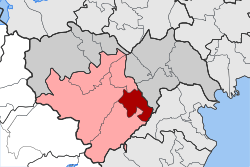
Back فيرغينا Arabic فيرجينا ARZ Вергина Bulgarian Vergina Catalan Vergína CEB Vergina Czech Vergina German Βεργίνα Greek Vergina Spanish ورجینا Persian
Vergina
Βεργίνα | |
|---|---|
| Coordinates: 40°29′N 22°19′E / 40.483°N 22.317°E | |
| Country | Greece |
| Administrative region | Central Macedonia |
| Regional unit | Imathia |
| Municipality | Veroia |
| Area | |
| • Municipal unit | 69.0 km2 (26.6 sq mi) |
| Lowest elevation | 120 m (390 ft) |
| Population (2021)[1] | |
| • Municipal unit | 2,034 |
| • Municipal unit density | 29/km2 (76/sq mi) |
| • Community | 1,096 |
| Time zone | UTC+2 (EET) |
| • Summer (DST) | UTC+3 (EEST) |
| UNESCO World Heritage Site | |
|---|---|
 | |
| Official name | Archaeological Site of Aigai (modern name Vergina) |
| Criteria | Cultural: i, iii |
| Reference | 780 |
| Inscription | 1996 (20th Session) |
| Area | 1,420.81 ha |
| Buffer zone | 4,811.73 ha |
Vergina (Greek: Βεργίνα, Vergína [verˈʝina]) is a small town in Northern Greece, part of Veria municipality in Imathia, Central Macedonia. Vergina was established in 1922 in the aftermath of the population exchanges after the Treaty of Lausanne and was a separate municipality until 2011, when it was merged with Veroia under the Kallikratis Plan.
Vergina is best known as the site of ancient Aigai (Ancient Greek: Αἰγαί, Aigaí, Latinized: Aegae), the first capital of Macedon. In 336 BC Philip II was assassinated in Aigai's theatre and his son, Alexander the Great, was proclaimed king. While the resting place of Alexander the Great is unknown, researchers uncovered three tombs at Vergina in 1977 – referred to as tombs I, II and III.
Tomb I contained Philip II, Alexander the Great's father, tomb II belonged to Philip III of Macedon, Alexander the Great's half-brother, while tomb III contained Alexander IV, Alexander the Great's son.[2][3]
Tomb I had been looted; Tombs II and III were intact and contained an array of burial goods. The ancient town was also the site of an extensive royal palace. The archaeological museum of Vergina was built to house all the artifacts found at the site and is one of the most important museums in Greece.[4]
Aigai has been awarded UNESCO World Heritage Site status as "an exceptional testimony to a significant development in European civilization, at the transition from classical city-state to the imperial structure of the Hellenistic and Roman periods".[4]
- ^ "Αποτελέσματα Απογραφής Πληθυσμού - Κατοικιών 2021, Μόνιμος Πληθυσμός κατά οικισμό" [Results of the 2021 Population - Housing Census, Permanent population by settlement] (in Greek). Hellenic Statistical Authority. 29 March 2024.
- ^ Antonis Bartsiokas, Juan Luis Arsuaga, Nicholas Brandmeir: The identification of the Royal Tombs in the Great Tumulus at Vergina, Macedonia, Greece: A comprehensive review. Journal of Archaeological Science: Reports, Volume 52, December 2023, https://doi.org/10.1016/j.jasrep.2023.104279
- ^ Antonis Bartsiokas (2024): The Identification of the Sacred “Chiton” (Sarapis) of Pharaoh Alexander the Great in Tomb II at Vergina, Macedonia, Greece. Journal of Field Archaeology, 1–13. https://doi.org/10.1080/00934690.2024.2409503
- ^ a b "Archaeological Site of Aigai (modern name Vergina)". UNESCO World Heritage Convention. United Nations Educational Scientific and Cultural Organization. Retrieved 25 November 2022.

